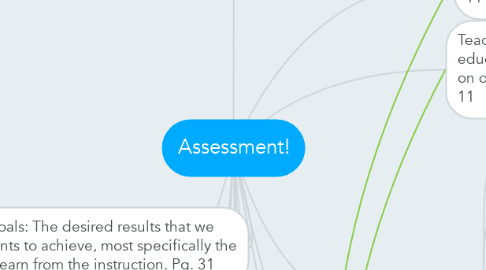Assessment!
作者:Chris Whitney

1. Intended Learning Outcomes: What we want our students to know by the end of a unit. An assessment should give them a chance to display this. pg. 33
2. Learner's Goals: The goals for the learner in any given assessment or unit. Meaning what they are to display whether it is knowledge or a certain skill. pg. 31
3. Instructional Goals: The desired results that we want out students to achieve, most specifically the skills they will learn from the instruction. Pg. 31
4. Measurement: The goal of an assessment is to measure student progress within given parameters. pg. 27
5. Relevant Instruction: Instruction including lessons and projects that tie directly to a given unit and plan. If an assessment is not based on relevant instruction it will not meet our learning goals. pg. 31
6. Subjectivity: The ability for an assessment to have opinion based answers. Pg. 128
7. Objectivity: The ability for an assessment to have hard quantifiable data. Pg. 128
8. Spread of Scores: The range of scores that are gathered within a given group. Pg. 127
9. Standard Error of Measurement: The amount that an assessment can differ within a group with a margin of basic error. Pg. 120
10. Teacher Evaluation: The methods that we as educators use to evaluate our own progress based on our student's assessments and other factors. pg. 11
11. Assessment Context: The area, subject and topic for which the assessment is given. Pg. 11
12. Test Types
12.1. Aptitude Test: A test designed to predict future success in a given area. pg. 35
12.2. Fixed Choice Assessment: a test such as a multiple choice exam. One that contains set answers. pg. 36
12.3. Complex Performance Assessment: An assessment such as a project that allows for creative displays of knowledge. Pg. 36
12.4. Placement Assessment: An assessment designed to determine student level prior to instruction. pg. 37
12.5. Formative Assessment: An assessment given during instruction to monitor basic progress. Pg. 37
12.6. Diagnostic Assessment: An assessment used to diagnose any learning difficulties. Pg. 37
12.7. Summative Assessment: A final assessment to determine student progress after instruction. Pg. 37
13. Necessary Qualities
13.1. Construct Vadlidity: The evaluation of the adequacy and appropriateness of an element. pg. 71
13.2. Reliability: The determination of consistent results. Pg. 71
13.3. Usability: The determination of the ability to utilize a given thing, such as an assessment. Pg. 72
13.4. Appropriate Design: The determination of an assessment's ability to fit the class and topic that is given. Pg. 72
13.5. Interpretation: The ability to interpret the data gathered from a given assessment. Pg. 73
13.6. Specificity: The ability to determine the accuracy of answers to a degree. Pg. 73
13.7. Unitary Design: The understanding that an assessment is designed in unison with other pieces, that it is not whole on its own and it needs to be part of a unit. Pg. 73
13.8. Evaluative Design: The ability for an assessment to determine progress based on work done. Pg 73
13.9. Representative Information: The ability for an assessment to show all the parts of a unit or subject. Pg. 75
13.10. Content Design: The ability for an assessment to contain sufficient content for a learner to show that they have met their learner's goals. Pg. 75
13.11. Construct Representation: The ability for an assessment to represent all the elements involved in the given unit or subject. Pg. 83
13.12. Correlation of Information: The ability of an assessment to be collected and factored into information to determine a student's progress when compared to learning goals and other elements. Pg. 85
13.13. Fairness: The appropriateness of an assessment given the learner's involved. Pg. 101
14. Qualities to test and be tested in an assessment
14.1. Test-Retest Method: Giving the same test twice to assess progress. Pg. 111
14.2. Equivalent Forms: Giving two forms of the same assessment to the same group close together and then correlate the data. Pg. 111
14.3. Split Half: Give the test once ,but score it in separate halves to judge the information gathered. pg. 111
14.4. Interrater: Have students respond to questions and then rate the scores independently. Pg. 111


